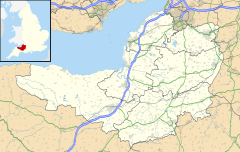Newton St Loe
| Newton St Loe | |
|---|---|
 Holy Trinity Church |
|
| Newton St Loe shown within Somerset | |
| Population | 681 (2011) |
| OS grid reference | ST703648 |
| Civil parish |
|
| Unitary authority | |
| Ceremonial county | |
| Region | |
| Country | England |
| Sovereign state | United Kingdom |
| Post town | BATH |
| Postcode district | BA2 |
| Dialling code | 01225 |
| Police | Avon and Somerset |
| Fire | Avon |
| Ambulance | South Western |
| EU Parliament | South West England |
| UK Parliament | |
Newton St Loe is a small Somerset village and civil parish located between Bath and Bristol in England. The majority of the village is owned by the Duchy of Cornwall. The parish has a population of 681.
The Saxon manor of Newton, held by Aluric in the time of King Edward the Confessor, was given to the bishop of Coutances by William the Conqueror. At the time of Domesday the bishop was Geoffrey de Montbray also known from his see as Geoffrey of Coutances, a Norman nobleman, trusted adviser of William and a great secular prelate, warrior and administrator. Newton St Loe takes its additional name from the family of St. Lo, who drew their name from Saint-Lô in Normandy; the family, Latinized in documents as "de Sancto Laudo", held the manor in the time of Richard I.
There is evidence of a 3rd-century Roman villa on a site between Newton St Loe and Bath on the south side of the River Avon. It was discovered in 1837 during the cutting of the Bristol-Bath railway line when excavations were carried out and drawings of the site made before much of it was lost in the railway construction. Two mosaics were removed, one of which, known as the Orpheus Mosaic, is now in the Bristol Museum and Art Gallery. A further investigation was carried out in 1968 before the widening of the A4 however it is still the case that little is known about the villa.
The parish was recorded in the Domesday Book with the name Niwetone. The parish of Newton St Loe was part of the Wellow Hundred.
...
Wikipedia

